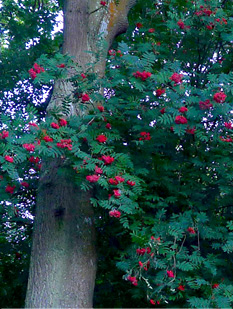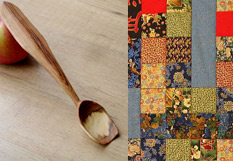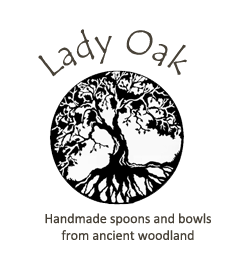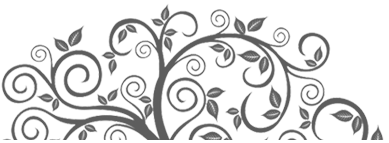


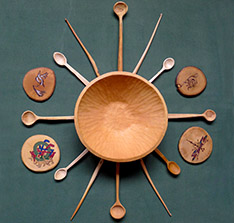
Inkle looms are constructed in both floor and table-top models and are characterized by a wooden framework upon which dowels have been fastened. These dowels will hold the warp threads although one of the dowels, or a paddle, is constructed so that its position can be adjusted. This tensioning device will be taken in as weaving commences and the warp threads become shorter.
This type of weaving has been around for centuries and the oldest inkle quotation in the Oxford English Dictionary dates from 1541: “For a pece of brode yncull for gyrdyllys.”
The inkle loom is threaded with warp threads according to the weaver's design, alternating between yarn that can be raised and lowered and yarn that is secured in place using heddles. The raising and lowering of these warp threads creates the shed through which the weft thread will be carried on a shuttle.
Inkle bands are quite strong and can be used in applications where a flat band is desired. Traditionally inkle braids were used for belts, reins and as trimming for garments and other textiles. Popular modern uses are for guitar and camera straps.
Tablet Weaving is a technique where tablets or cards are used to create the space (or shed) through which the weft is passed.
The method of weaving with tablets in Europe goes back to at least the 8th century BCE. Elaborate tablet-woven bands have been found in many high-status Iron Age and medieval graves and are thought to have been the standard trimming for garments among various European peoples. Museum examples exist of such bands being used on ecclesiastical textiles and as the foundation for elaborate belts in the European Middle Ages.
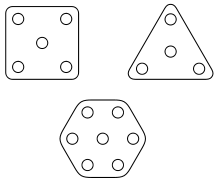 In the past, weavers made tablets from or a variety of other materials such as wood, horn and leather, modern cards are frequently made from cardboard and some weavers drill holes in a set of playing cards which is a quick way of getting a large number of inexpensive tablets.
In the past, weavers made tablets from or a variety of other materials such as wood, horn and leather, modern cards are frequently made from cardboard and some weavers drill holes in a set of playing cards which is a quick way of getting a large number of inexpensive tablets.
The tablets are generally marked in some way so that their facings and orientations can be easily noticed. The fundamental principle is to turn the tablets to lift selected sets of threads in the warp. The tablets may be turned in one direction continually as a pack, turned individually to create patterns, or turned some number of times "forward" and the same number "back". Traditionally, one end of the warp was tucked into, or wrapped around the weaver's belt, and the other is looped over a toe, or tied to a pole or furniture, or the warp was tied between two poles. Modern "tablet weaving looms" have adopted the pole method as these looms are more convenient as they make it easy to put the work down.
Patterns are made by placing different-coloured yarns in different holes, then turning individual cards until the desired colours of the weft are on top. After that, a simple pattern, like a stripe, small diamond or check, can be repeated just by turning the deck of tablets.
Quilting is the name given to the process of sewing several layers of fabric together to form a thicker material. This is generally used for adding warmth and protection to household items such as bedcovers and clothing because the air trapped between the layers increases insulation.
Quilting, as a craft, has its roots firmly embedded in tradition and examples of this craft can be found around the world. It is believed that while quilting was present in Europe from around the 5th century CE it was still a rather rare technique and it is with the return of the Crusaders in around the 12th century that quilted items became more evident.
It is thought that the Crusaders copied the method of using quilted garments to line their armour, thus protecting their bodies from the chaffing and coldness of the metal. These garments evolved over time to become the doublets that were a mainstay in European men’s fashion from the 14th to 17th centuries.
Quilted bedcovering also appeared with the return of the crusaders and the French were particularly skilled in the use of silks, velvets and satins to create exquisite, fanciful masterpieces.
The method of quilting bedspreads was taken to America by the Pilgrims but it is with the Pioneer women that ‘Patchwork’ really blossomed. These people were generally poor and every scrap of material was used. They would sew these odd scraps together which is the method known as ‘crazy quilting’ or they would use scraps of paper as templates, fold the material over these and then stitch them together, more often than not the paper was left in the finished item to provided added insulation. This is the method known as ‘paper quilting’ or ‘English Patchwork’.
Later trends show them using regular, geometric shapes to form ‘blocks’. These blocks were in turn sewn together to form the quilt top which was used as created or layered with other material to form a thicker ‘quilt’.
The names given to these blocks reflect their environment and their way of life, being called Bears Paw, Log Cabin, Ohio Star to name but a few.
Examples of Pioneer quilts are highly prized and many early examples are housed in museums and private collections. The Amish women are still famed for their skill and craftsmanship in the art of quilting.
Techniques have obviously changed over the years and the advent of longarm sewing machines and rotary cutters have made the task of piecing and sewing quilts easier but the designs and level of detail are as intricate as ever.
You can be assured that the sense of achievement at completing a quilt, that is both beautiful and functional, is still the same today as it must have been centuries ago.
Please contact us for more information on Lady Oak bespoke quilts. The photos shown are of our current stock of quilts.
